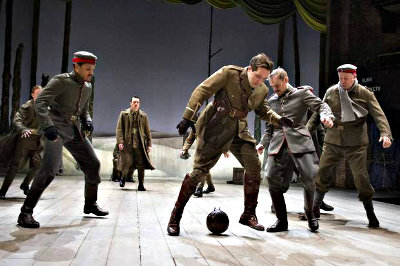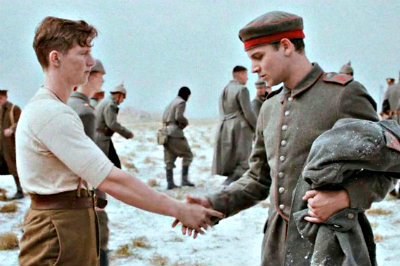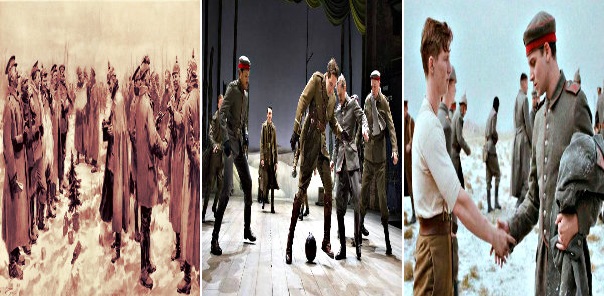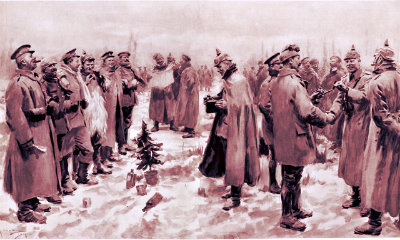While there are countless accounts giving evidence to the Christmas truce in the Great War a century ago, the football match so frequently associated with this celebrated truce maybe just a shot in the dark as there is very little evidence to support its occurrence.
As the 100th anniversary of the outbreak of the First World War is commemorated this whole year, another memorable Great War memory is also remembered — the Christmas Truce which supposedly happened during the first year of WWI, therefore, making the event a century old.
As a matter of fact, Great War’s Christmas Truce is ubiquitous. Many news portals carry stories, real accounts from letters of WWI soldiers, supporting that the truce did really happen. Just last month, British retail company Sainsbury released a moving Christmas advert with the story revolving around the concept of the Christmas Truce in 1914.
The stories about the century-old Christmas Truce taking place in the middle of WWI revolve around these main elements: an informal ceasefire between the two warring parties took place, soldiers met in No Man’s land exchanging pleasantries, greetings and small tokens, a friendly match of football took place before firing resumed bringing the short interlude of peace to an end.
However, former chairman of the Western Front Association Chris Baker, who has also authored a book about the truce, points out that though the reasons behind the emergence of the Christmas Truce symbolism are understandable, what really happened in reality a century ago was rather different.
The “Real” Story Behind the Christmas Truce in 1914
As what was mentioned beforehand that there are accounts supporting truces happening during Christmas of 1914, the notion of a single meeting between German and British soldiers in No Man’s land during WWI with this gathering ending in a friendly match of football is false.
Symbolists, as what the Sainsbury ad shows, might believe that the truce started with the Germans singing Stille Nacht right on Christmas Eve, but the truce really started much early on, said Chris Baker. As an example, the author cited one occurrence on December 11 that year — WWI soldiers of the second battalion of the Essex regiment met up with German soldiers on No Man’s Land that day.
According to him, a human being’s innate curiosity became an important factor in these truces. With trenches just less than one hundred yards apart, both servicemen of the warring sides could practically hear each other, smell the cigarette smokes coming from opposing trenches and, at times, take a glimpse of what it was like on the other side.
Aside from these factors, trenches in the early year of WWI were quite rudimentary, Chris Baker points out. He even describes them as “scratches on the ground”.
Baker goes on to say that the December weather that year had been wet with a cold snap taking place on the 23rd which froze the ground. At least, one part of the Christmas truce portrayal is true — it was really snow-flecked. Baker states that soldiers started to hear their enemies singing familiar Christmas tunes and showing lights. Messages were sent by putting notes in tin cans and throwing them to the opposite trench. Eventually, several of the men started to leave their trenches. were waved on by the other side and then, soldiers started to meet in the middle.
There were a few would-be fraternizers who were shot by snipers — something one wouldn’t witness in the Sainsbury advertisement or the play by the Royal Shakespeare Company.
Did the Football Match Occur?

But while there are many soldiers’ accounts about truces happening on Christmas day that year a century past, the football match associated with it comes with little evidence.
According to Baker, there are stories – taken from accounts of servicemen during the Great War – about the sport taking place in one or two areas in the WWI front lines. He goes on to state that the most likely place the friendly match of football would have happened was in an area near the village of Messines which is situated on the border between Belgium and France. Records state that the 16th Bavarian reserve infantry regiment and the Norfolk regiment’s first battalion played “something”. History show that there are two narratives from the British side about the match but none came up from the Germans. Baker indicates that as long as there are no stories of the said games from a German soldier, then, the narrations wouldn’t hold strong credibility.
One evidence to support the friendly football match during the Christmas truce is the letter, often quoted, which appeared in the Manchester Guardian on the New Year’s Eve of 1914. It went as follows:
“One officer met a Bavarian, smoked a cigarette, and had a talk with him about halfway between the lines. Then a few men fraternized in the same way, and really today peace has existed. Men have been talking together, and they had a football match with a bully beef tin, and one man went over and cut a German’s hair!”
However, the said narrative did not mention if the Germans were involved in the said “kickabout”. Additionally, a game involving a bully beef tin is a far-cry from a full-pledged football game envisioned in many symbolists’ minds. Baker further says that a football game may have been impossible to play in No Man’s Land as barbed wires were strewn about amidst bomb craters.
The Christmas Truce Imprint

One more thing Baker pointed out was that though the Christmas truce stayed in the minds of the soldiers who were able to witness and participate in it, it held no legacy during the duration of the Great War. While it was generally quiet when Boxing Day rolled in until the run-up of New Year, the blood and gore of WWI continued on after that short and icy interlude.
There were other truces occurring over the duration of the First World War but nothing like the scale which took place in 1914. As the years of the battle went on, the soldiers’ attitude hardened, the trenches evolved into being more systematic, the artillery became more accurate and the high rank officials less forgiving. The memories the Christmas truce created were forgotten, replaced by numbness brought about by the horrors of war.
The Christmas truce only reappeared some fifty years later when it was featured in the 1963 stage show and movie Oh! What A Lovely War. But Baker points out this obvious reality about it: the Christmas truce did not change anything during the First World War. However, it did give us a hopeful glimpse of humanity, that man is capable of acting differently than what is expected or ordered of him.

